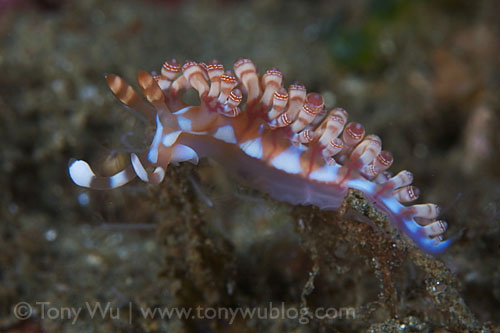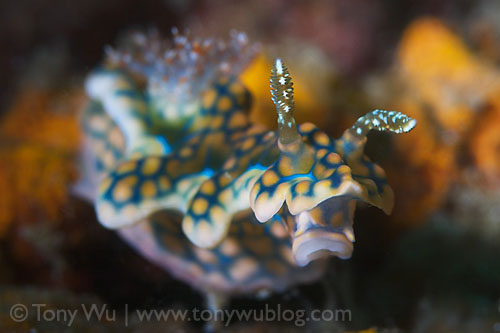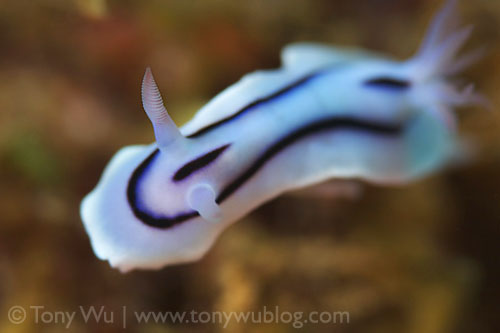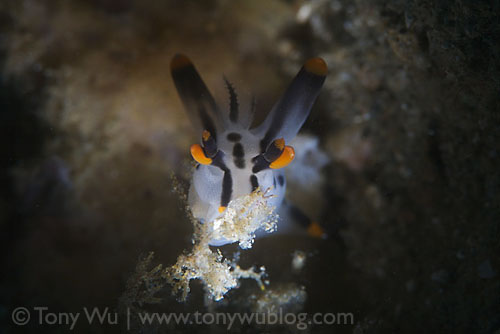The week has been totally chaotic...running around Bangkok, meeting friends, attending meetings...and making time for truly important stuff like (lots of) mango with sticky rice.
Things are finally settling down a bit, so I'm going to pick up again with some images from Ambon, starting with a few nudibranchs to illustrate the concept of lighting nuance.
First, take a look at this photo:

It's an unusual nudibranch (Flabellina bilas), at least for me, since it's the first time I've ever seen one of these. I like this image because the nudibranch is doing something...crawling from one lump of stuff to another, and also because it has funky paddle-like appendages.
The lighting for this picture is pretty standard though: two strobes...one left, one right...nothing terribly innovative. I chose this configuration because it's safe (i.e., I knew I could nail the shot) and also because I thought the nudibranch was a sufficiently interesting subject without trying for anything particularly creative.
Look what happens, however, when I use hard, directional lighting:

This is a nudibranch (Ceratosoma sinuatum) I've seen before (actually, on my first visit to Ambon), so I felt like I should play around a bit and try to do something more than hit it with normal lighting.
If you take a closer look, you'll see that there's relatively more light coming from front left than any other direction, thus creating shadows...and also, that the light comes in at a low angle...creating hard, distinct lines.
Think of late afternoon sunlight, and you'll get the idea.
The reason I did this (besides just for the sake of having fun) was the background. There's yellow-orange on the nudibranch, and there's a similar colour in the background. Shadows and strongly defined lines help to separate the nudibranch from the background...complementing the three-quarter, face-on perspective.
Next is an example of nearly the complete opposite...soft, diffuse lighting:

Why go soft and squishy here? Well...the background was incredibly cluttered, but perhaps more importantly, this is a really ho-hum normal nudibranch (Chromodoris sp.). There are probably a billion (give or take) photos of this and other similar nudibranchs taken with normal lighting. In other words, taking yet another normal photo would pose no challenge and add no value.
Hence soft focus + soft lighting...which gives the photo an ethereal, dreamy quality that makes even this no-so-special nudibranch look nice.
Finally, here's a nudibranch (Thecacera picta) portrait taken with pinpoint lighting, a technique I've been working on for some time now:

The lighting emphasis is almost entirely on the face (specifically the mouth area) of the nudibranch...because this one is feeding. It's eating the bryozoan or whatever it's perched upon.
Thecacera nudis aren't too rare in Indonesia, so applying unique lighting creates a different feel for a relatively common subject. I don't recall ever seeing a Thecacera portrayed in this manner, so of course, there's a measure of personal satisfaction involved too.
The message in all this rambling? The quality, as well as the quantity, of light you use significantly affects the way your subjects, and hence your photos, appear.